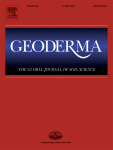Ver ítem
- xmlui.general.dspace_homeCentros Regionales y EEAsCentro Regional La Pampa - San LuisEEA AnguilArtículos científicosxmlui.ArtifactBrowser.ItemViewer.trail
- Inicio
- Centros Regionales y EEAs
- Centro Regional La Pampa - San Luis
- EEA Anguil
- Artículos científicos
- Ver ítem
Soil type affects biological phosphorus cycling more than soil management
Resumen
There is a need for more sustainable management of phosphorus (P) fertilization including reutilization of wastes and taking more advantage of the biological cycling of P in the crop-livestock-soil system to comply with the Sustainable Development Goals. The objective of the present study was to evaluate the effect of soil type and management on microbial carbon (C) and P transformations (mineralization-immobilization processes) and their seasonal
[ver mas...]
There is a need for more sustainable management of phosphorus (P) fertilization including reutilization of wastes and taking more advantage of the biological cycling of P in the crop-livestock-soil system to comply with the Sustainable Development Goals. The objective of the present study was to evaluate the effect of soil type and management on microbial carbon (C) and P transformations (mineralization-immobilization processes) and their seasonal fluctuations throughout the year to assess the feasibility of enhancing biological P cycling by changing crop rotations. A sandy loam petrocalcic Paleustoll with a calcium carbonate hardpan at approximately 0.8 m depth, and a sandy typic Ustipsamment were selected in the Argentinean semiarid Pampa. Soil management treatments were a 50-year-old Weeping Lovegrass pasture (PP) and three agricultural plots belonging to long-term trials with and without cover crops under no-till: maize monoculture (M−M), maize-rye (M−R), and maize-vetch (M−V). Soil microbial biomass C and P (MBC, MBP), soil respiration, metabolic quotient, P mineralization rate, and anion exchange membrane extractable P (solution P) were determined during winter and spring of 2017, and summer and autumn of 2018 at 0–0.05 and 0.05–0.10 m depth. Results indicated that differences in the relationships between MBP and MBC were mostly influenced by soil type. In the Paleustoll, this relationship showed a threshold value of 94.7 µg MBC g−1 where soil microbial biomass P reached a maximum value of 6.6 ug MBP g−1. No relationship between P mineralization rate and MBP was observed in this soil indicating P limitation explained by the negative relationship between exchangeable calcium and solution P. On contrary, a positive and linear relationship between MBP and MBC was found in the Ustipsamment, which was affected by the season of the year. A nonlinear relationship between metabolic quotient and MBP was found in the Ustipsamment but not in the Paleustoll. Soil management was more related to microbe-plant P competition during periods of active growth in the Paleustoll, while in the non-P limited soil (Ustipsamment), environmental conditions and the presence of active rhizosphere stimulate microbial activity, shown by seasonal variations, increasing P mineralization rates to sustain microbial and plant P demand.
[Cerrar]

Autor
Frasier, Ileana;
Noellemeyer, Elke;
Gili, Adriana;
Gomez, María Florencia;
Uhaldegaray, Mauricio Gaston;
Quiroga, Alberto Raul;
Fernandez, Romina;
Alvarez, Lucila;
Fuente
Geoderma 426 : Article 116091 (November 2022)
Fecha
2022-08-10
Editorial
Elsevier
Documentos Relacionados
Formato
pdf
Tipo de documento
artículo
Proyectos
(ver más)
INTA/2019-PD-E2-I037-002/2019-PD-E2-I037-002/AR./Biodiversidad edáfica: componente clave para una gestión integral y sustentable del recurso suelo
Palabras Claves
Derechos de acceso
Restringido
 Excepto donde se diga explicitamente, este item se publica bajo la siguiente descripción: Creative Commons Attribution-NonCommercial-ShareAlike 2.5 Unported (CC BY-NC-SA 2.5)
Excepto donde se diga explicitamente, este item se publica bajo la siguiente descripción: Creative Commons Attribution-NonCommercial-ShareAlike 2.5 Unported (CC BY-NC-SA 2.5)

